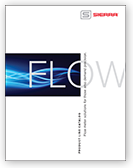Official Blog of Sierra--Let's Talk Flow!
Accuracy in Gas Mixing & Blending
In my last post, I discussed the important question of Mass or Volume flow measurement. Today, I will discuss accuracy and the need to size your mass flow controller properly to assure the highest quality gas mixing and blending.
Mass flow controllers are devices that have an accuracy of % of full scale (%FS). That means that the uncertainty of a 1% device is 1% of the maximum flow range of the instrument. For example, if you purchase a mass flow controller with a range of 0-500 SLPM and the unit has an uncertainty 1% of full scale, the uncertainty is 1% of 500 = 5 SLPM. So, when you control a mass flow rate of 500 SLPM, the flow can be between 495 to 505 SLPM. However, if you control mass flow rate at 10 SLPM using the same 500 SLPM instrument, the uncertainty is still +/-5 SLPM. As a result, the controlled flow could be anywhere between 5 SLPM up to 15 SLPM. Pretty bad!
In contrast to instruments that measure % of full scale, there are instruments that measure % of measured value (also known as % of reading). Instruments like Sierra’s Primary Standard Flow Calibrators , family of Ultrasonic Liquid Flow Meters or Coriolis meters are % of measured value instruments. These instruments tend to be more expensive than % of full scale instruments. The good news is that the newest generation of high performance Thermal Mass Flow Controllers have drastically improved with the aid of advanced electronics, sensor and laminar flow element desig and linearization mathematics are getting closer to being % of Measured Value devices. And for a gas mixing and blending application requiring multiple mass flow controllers, the price of the instrument matters.
So, by this point in my post, you’re probably wondering what all this means for gas mixing applications? Well, the lesson learned is that the absolute accuracy is not as good when you operate the mass flow controller at the bottom of the maximum flow range of the instrument, so size your instrument correctly. This sizing of mass flow controllers in a gas mixing system is critical. You should be very clear what the purpose and the operational range of each mass flow controller in your gas mix system should be. Ask the manufacturer of the instrument to assist you as they probably have many customers faced with the same challenge. My next post two posts will focus on K-Factors and then I will discuss Dilution.
Paul de Waal, Managing Dir., Sierra Europe
Sierra Instruments

 Go to Autotest Division >
Go to Autotest Division > DOWNLOAD
DOWNLOAD